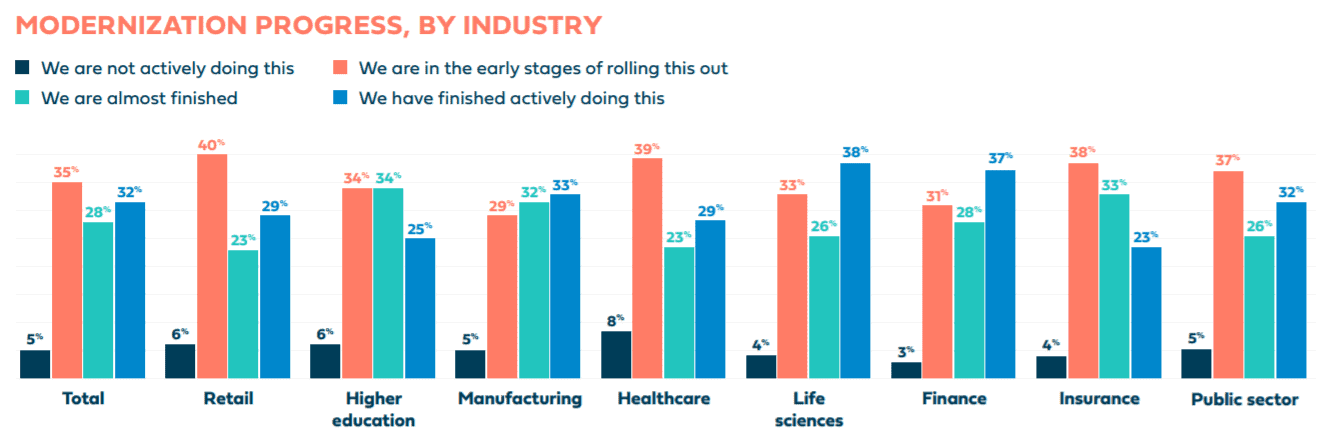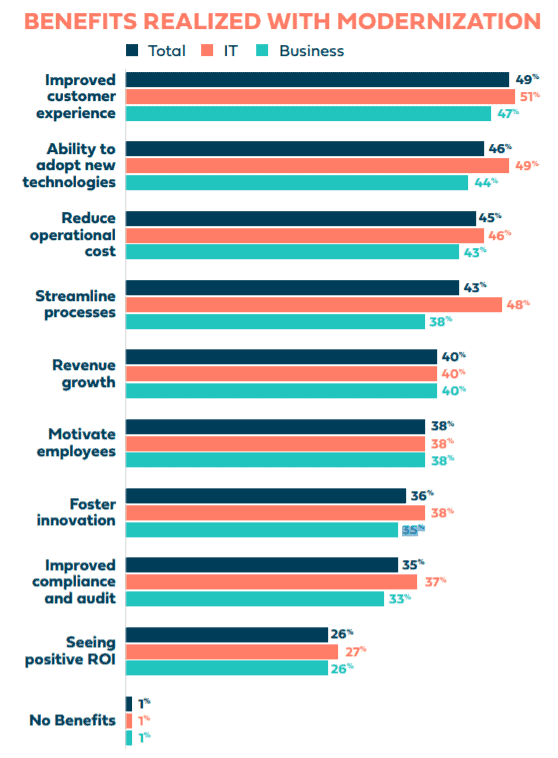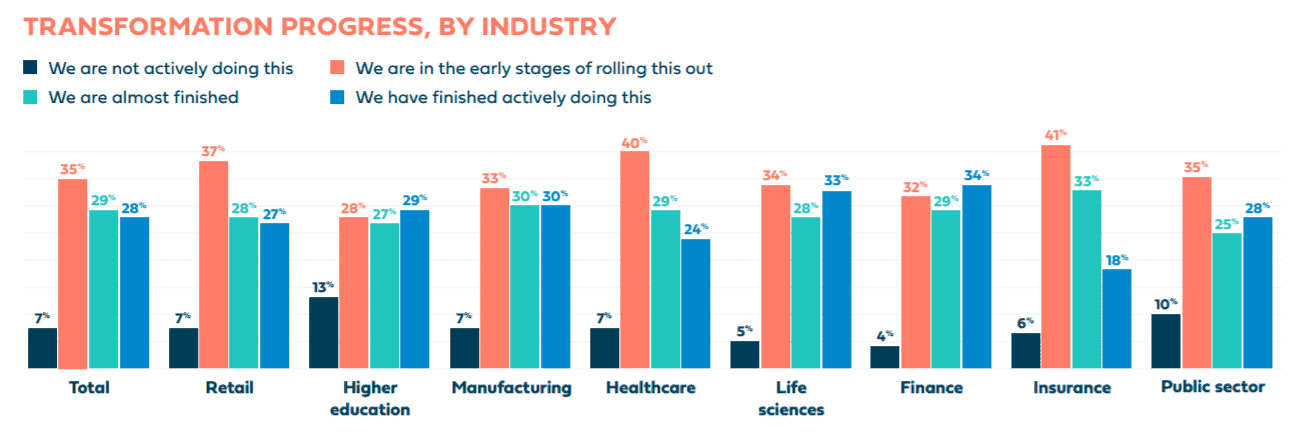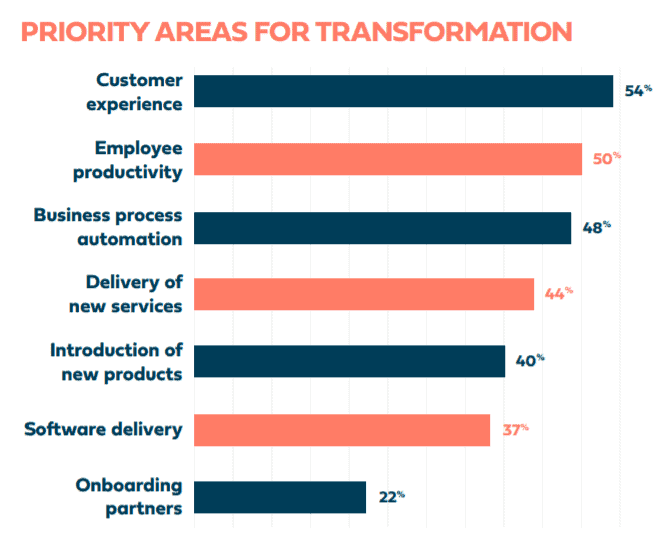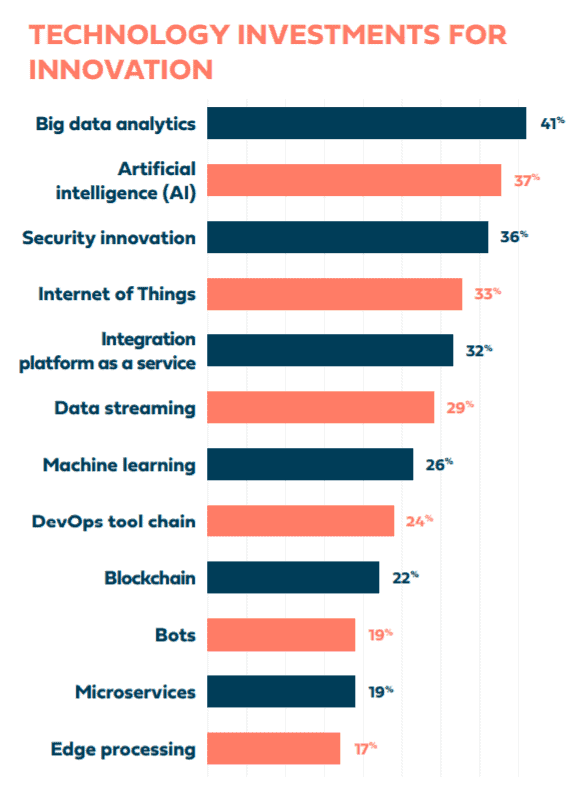Modernization, Transformation and Innovation in Business
The 2020 Dell Boomi IT and Business Report highlighted key technological areas businesses are taking advantage of as “leap-frogs” into digital transformation. So what exactly are these catalysts that are driving the modernization, transformation and innovation in business?
Organizations across the globe continue to be propelled into the “new normal” of digitally-driven business practices. Businesses are consistently looking for new ways to digitize and enhance their existing processes, along with the human workers that encompass them. In the 2020 Dell Boomi IT and Business Report, Ed Macosky, Senior Vice President of Product, UX and Solutions at Dell Boomi, coined this period as the “state of modernization, transformation and innovation in business”.
Boomi commissioned Vanson Bourne (a popular IT research firm) to survey more than 1,200 businesses and IT decision makers across 19 countries to obtain the data provided in the 2020 report. To better illustrate the digital transformation of businesses in 2020, and highlight the key findings in each of these areas, let’s first set the groundwork for how these three pillars are defined:
Modernization in Business – Key Findings, Benefits & Roadblocks
The report indicates that 94% of the surveyed organizations are actively modernizing their current business processes. Though innovation in business isn’t a completely new phenomenon, most organizations are still in the early stages of modernization in a general sense. However, there is a sizable percentage of businesses in certain industries that are actively modernizing, or have even finished modernizing their legacy systems.
Image from: Dell Boomi Report
Here are a few heavy hitters that are making strides in the realm of modernizing legacy processes:
Life Sciences – 38% finished modernizing
Finance – 37% finished modernizing
Manufacturing – 33% finished modernizing
Higher Education – 34% almost finished
One of the top benefits of modernizing systems in businesses is the customer experience enhancement, which seemed prevalent across various industries. Among the other primary benefits cited by the surveyed companies include reducing operational costs, innovating faster with better methods, and introducing automation into existing processes. There was a very small percentage (roughly 1%) that claim they saw no benefits from modernization whatsoever. It’s important to note that IT decision makers are much more likely to perceive the benefits of modernization than business decision makers.
Both IT and business decision makers are in agreement on the barriers of modernization that exists in these organizations. Budgetary challenges was the most dominant roadblock in the modernization journey within these businesses, which was more prevalent in the public sector and healthcare. Among these challenges was also limited technical knowledge (which exists more within business users).
OUR PRO TIPS – Modernization:
Trying to maintain old legacy applications are a popular stronghold preventing organizations from modernizing their systems, and responding to quickly changing business conditions. Here’s some tips to overcoming this challenge:
Transformation in Business
Digital transformation has been a staple in business enhancement in the recent years. Various organizations realize the dangers of falling through the cracks among more digitized competitors, and are actively seeking to transform outdated processes and systems. It’s reported that 92% of organizations surveyed stated that they’re either actively transforming digitally, or in the process of transforming.
Image from: Dell Boomi Report
Similar to modernization, one of the most prevalent benefits was reported to be customer experience enhancement. Across various B2B and B2C-driven industries, these organizations recognize the importance of streamlining both the processes and user experience present within the consumer life cycle. A very close second to customer experience was internal employee engagement.
Digital transformation among these surveyed companies has specific focuses propelling them to adopt a practical mindset of innovation. 48% of transformational focus within these businesses stemmed from process automation initiatives, while 44% reported a focus of introducing and delivering completely new products and services.
Pertaining to the key decision makers driving both the project management and the investment of these initiatives, nearly half of cross-industry organizations say that top-level leadership is the driving force behind the movement. However, it’s very important to note that 21% of digital transformation priorities are reported to place a heavier importance on IT specifically, with thought-leaders leading the charge in this space.
OUR PRO TIPS – Transformation:
Digital transformation first involves a business transformation, which entails empowering a culture of challenging the status quo. This also means failing fast, and taking risks in pursuit of radical internal/external improvements.
Innovation in Business – The Driving Force
Some would make the argument that both digital transformation and modernization aren’t possible without first adopting a mindset of innovation. While a dense 93% of organizations report they are digitally innovating, the stages of the innovation journey vary among specific industries. Retail, life sciences and finance/accounting functions are the most fluent industries pertaining to innovative practices. However, some areas like the public sector remain stagnant in their innovation journey, with 19% of these companies reporting they experience little to no innovative initiatives.
Technology Investments for Innovation in Business
The desired outcomes for innovation in business is similar to those of modernization and transformation. Improving customer experience seems to be the leading factor in all of these initiatives, with over half of companies stating this is the primary driver of introducing innovative tactics. Gaining a reputation in their industry was also a major influence, with just below half of cross-industry organizations noting this was a key innovation driver.
Secondly, another important factor in these initiatives is the desire to gain and retain customer loyalty, while simultaneously retaining a competitive advantage. Further, it’s important to note the desire to “not want to be left behind” was a completely separate area reported, with around 36% of companies saying this was a primary factor in their innovative modeling.
“Without an innovative and agile technology foundation, organizations risk being leapfrogged by more nimble rivals.”
–Dell Boomi Report
OUR PRO TIPS – Innovation:
Innovation begins with ideation, and empowering a culture of possibilities and risks within your business. Innovative and transformation ideas are often locked inside of employees minds, whom are unable to find sponsors who are not afraid to listen, understand, support and promote. Here’s how you can mitigate this roadblock:
Modernization, Transformation and Innovation in Business are the “New Normal”
Even amidst economic downturn, organizations are still prioritizing and empowering a mindset of innovation within their business. Adaptation to the new normal involves not only digitally transforming your operations altogether, but investing in robust technologies that streamline existing processes, and provide a base to agile/dynamic methodologies.
The main focus for many enterprise-level organizations is to transform user experience both from the customer-facing side, and the internal/partner-facing side. Further, these organizations recognize that gaining and maintaining a competitive edge during these times could be a make-or-break moment for their business. Investing in not only these technologies, but the business transformation that follows will remain a critical component of organizational success now, and for years to come.
Looking for more?
Explore more Modernization, Digital Innovation, and Application Development Expertise:
Keep Reading: 5 Key Steps to Enhancing IT Productivity
There’s more to explore at Smartbridge.com!
Sign up to be notified when we publish articles, news, videos and more!
Other ways to
follow us:


